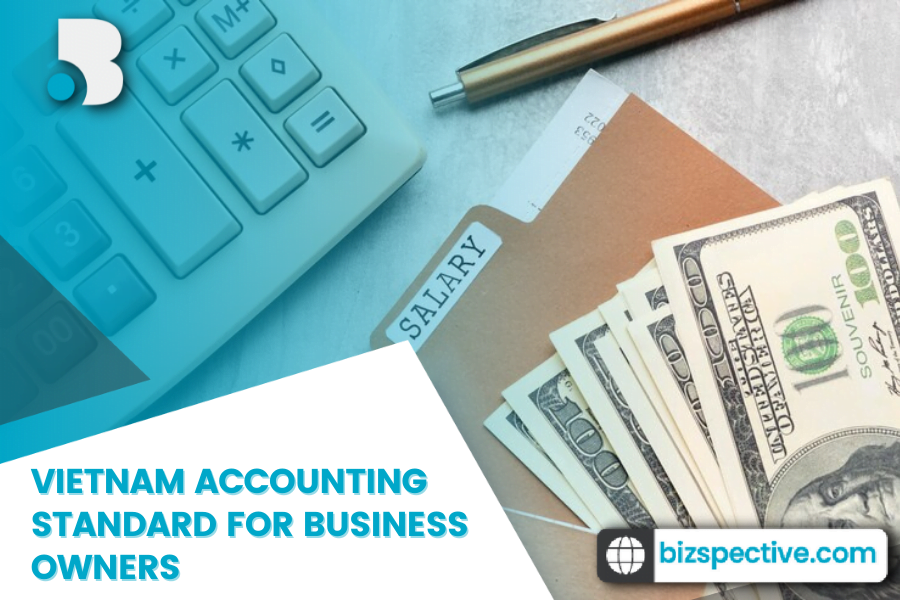As a foreign business owner in Vietnam, understanding Vietnam accounting standards is crucial to make sure that you meet the business compliance requirements in Vietnam.
Local and foreign companies must document financial transactions in accordance with Vietnam Accounting Standards (VAS), which were developed by the Vietnamese Ministry of Finance, in addition to the Accounting Law. The Vietnam Accounting Standards provide the methods for bookkeeping, financial reporting, and financial statement preparation.
For companies in the insurance, securities, and money management industries, there are industry-specific Vietnam accounting standards.
The Vietnamese Government now has 26 Vietnamese Accounting Standards, most of which are based on the International Financial Reporting Standards (IFRS), although with certain modifications to match Vietnam’s needs.
Table of Contents
Entities subject to Vietnam Accounting Standards (VAS)
Any businesses mentioned below must follow the basic standards established in the Law on Accounting, as well as all of Vietnam Accounting Standards released by the Ministry of Finance (MOF) and government:
- All economic entities functioning in Vietnam, including entirely foreign-owned companies, branches, and representative offices of foreign enterprises, which are governed by Vietnamese law.
- Individuals, family businesses, and cooperative groups.
- Accountants and other accounting professionals.
- Non-profit organizations and businesses (including with and without funding from the State budget).
Accounting and tax compliance for Vietnamese Representative Offices (RO)
A representative office must provide the following information in their annual tax report:
- General information includes phone number, representative office address, and principal bank contact.
- A summary of the previous year’s business operations including market research, advertising, service agreement marketing, and a variety of other activities will be included in the report.
- Human resource reports include salary, insurance, benefits, bonuses, and other forms of payment. Personal information and work responsibilities for each employee must be documented.

Accounting timeline
All companies subject to the Accounting Law must prepare a compilation of accounting records on a monthly, quarterly, or yearly basis in line with the accounting period stated as follows:
- Yearly accounting period: the calendar year (from January 1st to December 31st)
- Quarterly accounting period: 3 months (from the 1st of the first month of the quarter to the last day of the last month of the quarter)
- Monthly accounting period: 1 month (from the 1st of the month to the last of the month)
The first accounting period for newly formed businesses runs from the date of issue of the Business Registration Certificate until the end of the monthly, quarterly, or annual accounting period.
Language and currency requirements in Vietnam Accounting Standards (VAS)
All financial reporting must be done in Vietnamese.
Accounting currency is:
(i) mostly utilized in the selling and purchasing of products and services
(ii) have a significant impact on selling prices and company costs
(iii) used as the currency of selling prices and business cost payments
As a result, a corporation can choose its accounting currency. However, if you use foreign currency to make financial reports, you must inform your immediate supervisory tax authority.
One thing to keep in mind is that when a company publishes its financial statements for public view or submission to regulatory bodies, it must convert accounting currency to Vietnam dong (VND).

Main differences between Vietnam Accounting Standards and International Financial Reporting Standards
Even though the Vietnam Accounting Standards (VAS) are primarily based on the International Financial Reporting Standards (IFRS), there are certain key differences between the two that overseas investors should be aware of when they decide to start a business in Vietnam.
Financial Statement Presentation
Cash Flow Statements (CFS)
According to the International Financial Reporting Standards (IFRS), the Cash Flow Statement is essentially derived from the starting and ending balances of the financial position statement (IFRS). Cash accounts and bank deposits are used in the general ledger per the Vietnam Accounting Standards (VAS).
Cash Flow Statements are reported in one of two ways. Both IFRS and VAS define two types of Cash Flow Statement reporting for operating activities: direct and indirect. The direct method is preferred by IFRS, while the indirect method is preferred by VAS.

Inventories
Regarding inventories, both IFRS and VAS use the standard costing approach to determine production costs. There are, however, certain distinctions, which are noted below.
(*) costs accrued up to the time of asset acquisition.
(**) the direct cost of commodities, excluding fixed expenses, including costs for material and labor used in manufacturing.
Chart of accounts
Only broad rules and requirements for preparing and presenting financial accounts are provided by the International Financial Reporting Standards (IFRS). Meanwhile, all accounting units must utilize the Vietnam Ministry of Finance’s uniform chart of accounts for financial statements.
